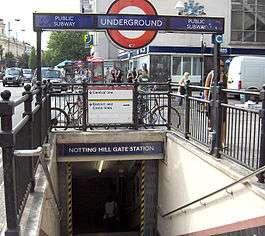Notting Hill Gate tube station
| Notting Hill Gate | |
|---|---|
|
Entrance through a subway | |
 Notting Hill Gate Location of Notting Hill Gate in Central London | |
| Location | Notting Hill |
| Local authority | Royal Borough of Kensington and Chelsea |
| Managed by | London Underground |
| Number of platforms | 4 |
| Fare zone | 1 and 2 |
| London Underground annual entry and exit | |
| 2012 |
|
| 2013 |
|
| 2014 |
|
| 2015 |
|
| Key dates | |
| 1868 | Opened (MR) |
| 1900 | Opened (CLR) |
| 1959 | Combined Station Opened |
| Other information | |
| Lists of stations | |
| WGS84 | 51°30′32″N 0°11′49″W / 51.509°N 0.197°WCoordinates: 51°30′32″N 0°11′49″W / 51.509°N 0.197°W |
|
| |
Notting Hill Gate is a London Underground station in the street known as Notting Hill Gate. On the Central line, it is between Holland Park to the west and Queensway to the east. On the District line and Circle line it is between High Street Kensington and Bayswater stations. It is on the boundary of Travelcard Zone 1 and Zone 2.
History
The sub-surface Circle and District line platforms were opened on 1 October 1868 by the Metropolitan Railway (MR) as part of its extension from Paddington to Gloucester Road. The Central line platforms were opened on 30 July 1900 by the Central London Railway (CLR). Entrances to the two sets of platforms were originally via separate station buildings on opposite sides of the road and access to the CLR platforms was originally via lifts.
The station name Notting Hill Gate had potential for confusion with the MR station to the north in Ladbroke Grove which was known as "Notting Hill" when opened in 1864, and renamed "Notting Hill & Ladbroke Grove" in 1880. This latter station eventually, in 1919, dropped its reference to Notting Hill, becoming "Ladbroke Grove (North Kensington)" in 1919 and, simply, "Ladbroke Grove" in 1938 (see Ladbroke Grove tube station).
Redevelopment
The station was rebuilt in the late 1950s and reopened on 1 March 1959 linking the two 'Notting Hill Gate stations' on the Circle and District and Central lines, which had previously been accessed on either side of the street, with a shared sub-surface ticket hall with escalators down to the Central lines. The escalators were the first on the Underground to have metal side panels rather than wooden. The new entrance also acts as a pedestrian subway under the widened Notting Hill Gate. The mosaic columns at the Southern Entrance were created in 2006 by local public art organisation Urban Eye.
Modernisation
The station was redecorated in 2010-11, with new ceramic tiling throughout the subway entrances, deep-level passageways and Central line tube platforms as well as a modified ticket hall layout.
During the redecoration works a section of lift passageways from the original 1900 CLR station, abandoned during the 1959 reconstruction, was rediscovered and found to contain a series of original posters. Images have been posted here Old posters at Notting Hill Gate station
A scheme was developed by the architects Weston Williamson to provide canopies over the entrances from the street,[2] but this has not been implemented.
Nearby places
Media appearances
In the 1968 film Otley, one of the Central line platforms at Notting Hill Gate (or a station pretending to be it) is where the assassin and coach driver Johnston, played by Leonard Rossiter, blows himself up opening a booby-trapped suitcase full of money.
The station and its staff featured prominently in the third episode of BBC Two documentary series The Tube, which first aired on 5 March 2012.
Layout
The westbound Central line platform is located above the eastbound platform because when the CLR was built it did not want to tunnel under buildings, and the street above was not wide enough for the two platforms to be side-by-side.
Connections
- London Buses routes 27, 28, 31, 52, 70, 94, 148, 328, 390 and 452 and night routes N28, N31 and N207 serve the station
- Oxford Tube X90 coaches.
Gallery
| Wikimedia Commons has media related to Notting Hill Gate tube station. |
 District & Circle line platforms (September 2006)
District & Circle line platforms (September 2006) Roof over District & Circle line platforms (September 2006)
Roof over District & Circle line platforms (September 2006)- Eastbound Central line platform looking west before refurbishment
References
- 1 2 3 4 "Multi-year station entry-and-exit figures" (XLS). London Underground station passenger usage data. Transport for London. April 2016. Retrieved 3 May 2016.
- ↑ "London Underground Entrance Canopies". Weston Williamson Architects. Retrieved 28 April 2011.
External links
| Preceding station | Following station | |||
|---|---|---|---|---|
| Central line | ||||
| Circle line | towards Edgware Road |
|||
towards Wimbledon | District line Wimbledon-Edgware Road |
